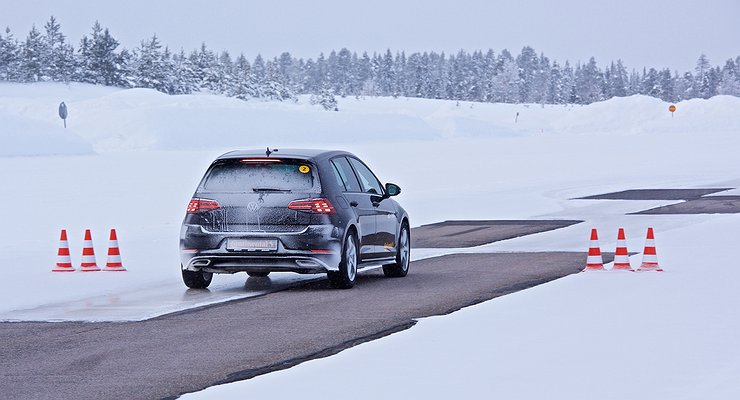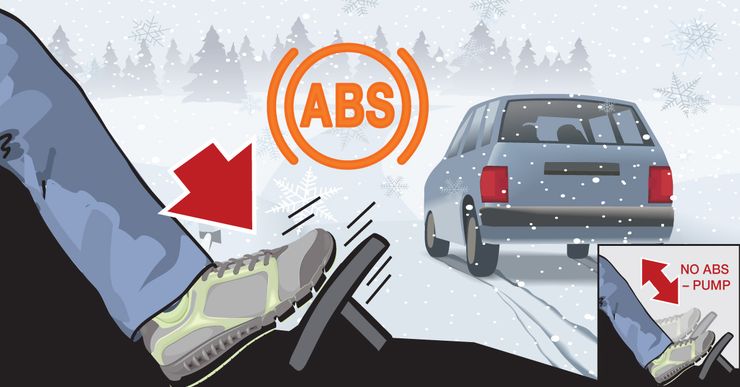How to shorten the braking distance of a car by 30% in winter
- January 27, 2023
- 0
A modern car with all its electronic gadgets can do a lot. But he doesn’t have the ability to build his own experience of acting in emergency situations.
A modern car with all its electronic gadgets can do a lot. But he doesn’t have the ability to build his own experience of acting in emergency situations.

The fact is that the ABS system, on which we hope so much, has a curious feature. It has been developed to ensure reliable deceleration of the car on slippery surfaces. In fact, it is simply required that the driver commands its activation. This command is a strong application of the brake, which locks the wheels.
The paradox of the situation, however, is that ABS works well with an inexperienced driver. But soon it leads the professional to the fact that the level of his skills is reduced to a beginner, devoid of proper work with the brake. After all, if you press the pedal too hard during braking and the wheels lock up, the ABS is activated, which ensures an “effective” deceleration.
But the essence of this system is that it responds to pilot error by momentarily reducing the force in the braking mechanism. And it decreases until the wheel rolls again. On ice (especially if the wheel is heavy and wide) this takes a very long time. Then the wheel is locked again. Due to such an algorithm of actions of the control electronics, the proportion of time when the wheel is effectively braking will decrease. What conclusion do we come to? To the unexpected.
The fact is that in winter we should not perceive ABS as an assistant who brakes effectively, but rather as a strict examiner who evaluates the correctness of our actions. Therefore, if an emergency stop is necessary, we must quickly move our foot from the gas to the brake and hit it strongly with a force of at least 40 kg. This will lead to guaranteed wheel lock and ABS activation. So we were trying to learn something new? Everything is correct. This is the first stage of braking. After the ABS is activated, we move on to the second – already quite professional.
We gradually begin to reduce the force on the pedals until the operation of the anti-lock braking system goes from continuous to the so-called borderline. In it, ABS does not start working constantly, but in episodes. And it’s in this mode that the wheels are usually on the verge of locking up, meaning they provide the most effective deceleration. And with the right actions on your part, you can shorten the braking distance by 30% compared to regular ABS operation. But even here not everything is easy.
When interacting with the brake pedal, the driver’s right foot acts rough and amplitude (thanks, among other things, to active safety assistants). In addition, during an emergency stop it is psychologically difficult to force yourself to reduce the force on the pedals at a time when all reflexes demand to pedal even harder.
Such a braking mode is therefore difficult to train on your own and is better done on the track under the guidance of a professional. Moreover, with the availability of time and relatively little money, such an opportunity exists in almost every region. And since this skill can save lives, we recommend taking it seriously.

The fact is that the ABS system, on which we hope so much, has a curious feature. It has been developed to ensure reliable deceleration of the car on slippery surfaces. In fact, it is simply required that the driver commands its activation. This command is a strong application of the brake, which locks the wheels.
The paradox of the situation, however, is that ABS works well with an inexperienced driver. But soon it leads the professional to the fact that the level of his skills is reduced to a beginner, devoid of proper work with the brake. After all, if you press the pedal too hard during braking and the wheels lock up, the ABS is activated, which ensures an “effective” deceleration.
But the essence of this system is that it responds to pilot error by momentarily reducing the force in the braking mechanism. And it decreases until the wheel rolls again. On ice (especially if the wheel is heavy and wide) this takes a very long time. Then the wheel is locked again. Due to such an algorithm of actions of the control electronics, the proportion of time when the wheel is effectively braking will decrease. What conclusion do we come to? To the unexpected.
The fact is that in winter we should not perceive ABS as an assistant who brakes effectively, but rather as a strict examiner who evaluates the correctness of our actions. Therefore, if an emergency stop is necessary, we must quickly move our foot from the gas to the brake and hit it strongly with a force of at least 40 kg. This will lead to guaranteed wheel lock and ABS activation. So we were trying to learn something new? Everything is correct. This is the first stage of braking. After the ABS is activated, we move on to the second – already quite professional.
We gradually begin to reduce the force on the pedals until the operation of the anti-lock braking system goes from continuous to the so-called borderline. In it, ABS does not start working constantly, but in episodes. And it’s in this mode that the wheels are usually on the verge of locking up, meaning they provide the most effective deceleration. And with the right actions on your part, you can shorten the braking distance by 30% compared to regular ABS operation. But even here not everything is easy.
When interacting with the brake pedal, the driver’s right foot acts rough and amplitude (thanks, among other things, to active safety assistants). In addition, during an emergency stop it is psychologically difficult to force yourself to reduce the force on the pedals at a time when all reflexes demand to pedal even harder.
Such a braking mode is therefore difficult to train on your own and is better done on the track under the guidance of a professional. Moreover, with the availability of time and relatively little money, such an opportunity exists in almost every region. And since this skill can save lives, we recommend taking it seriously.
Source: Avto Vzglyad
Donald Salinas is an experienced automobile journalist and writer for Div Bracket. He brings his readers the latest news and developments from the world of automobiles, offering a unique and knowledgeable perspective on the latest trends and innovations in the automotive industry.